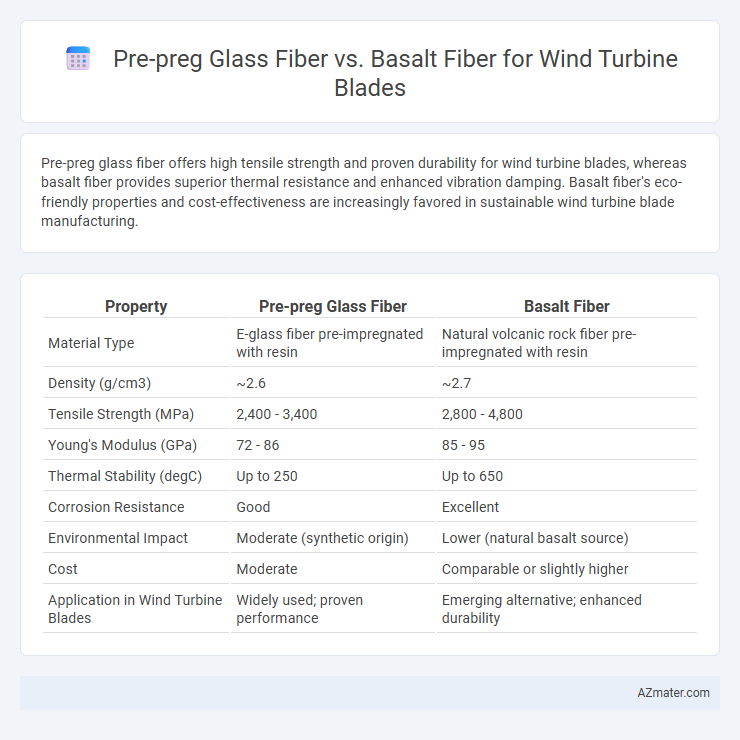Pre-preg glass fiber offers high tensile strength and proven durability for wind turbine blades, whereas basalt fiber provides superior thermal resistance and enhanced vibration damping. Basalt fiber's eco-friendly properties and cost-effectiveness are increasingly favored in sustainable wind turbine blade manufacturing.
Table of Comparison
| Property | Pre-preg Glass Fiber | Basalt Fiber |
|---|---|---|
| Material Type | E-glass fiber pre-impregnated with resin | Natural volcanic rock fiber pre-impregnated with resin |
| Density (g/cm3) | ~2.6 | ~2.7 |
| Tensile Strength (MPa) | 2,400 - 3,400 | 2,800 - 4,800 |
| Young's Modulus (GPa) | 72 - 86 | 85 - 95 |
| Thermal Stability (degC) | Up to 250 | Up to 650 |
| Corrosion Resistance | Good | Excellent |
| Environmental Impact | Moderate (synthetic origin) | Lower (natural basalt source) |
| Cost | Moderate | Comparable or slightly higher |
| Application in Wind Turbine Blades | Widely used; proven performance | Emerging alternative; enhanced durability |
Introduction to Wind Turbine Blade Materials
Wind turbine blades require materials that combine high strength, lightweight properties, and durability to withstand harsh environmental conditions and mechanical stresses. Pre-preg glass fiber offers excellent tensile strength and cost-effectiveness, making it a traditional choice for blade manufacturing. Basalt fiber emerges as a sustainable alternative with superior thermal stability, corrosion resistance, and improved fatigue performance, enhancing the overall lifespan and reliability of wind turbine blades.
What is Pre-preg Glass Fiber?
Pre-preg glass fiber is a composite material consisting of glass fibers pre-impregnated with a resin matrix, typically epoxy, which ensures precise resin-to-fiber ratios and consistent quality for manufacturing wind turbine blades. This material offers high strength-to-weight ratio, excellent fatigue resistance, and improved structural performance compared to traditional wet lay-up methods. The controlled curing process of pre-preg glass fiber enhances blade durability and reduces defects, making it a preferred choice in advanced wind turbine blade production.
Understanding Basalt Fiber in Blade Manufacturing
Basalt fiber offers higher temperature resistance and improved vibration damping compared to traditional pre-preg glass fiber, making it a promising alternative for wind turbine blade manufacturing. Its natural volcanic origin provides enhanced mechanical properties and environmental sustainability, reducing the carbon footprint associated with composite materials. Integrating basalt fiber improves blade durability and longevity in harsh operating conditions, optimizing turbine performance and maintenance cycles.
Mechanical Properties Comparison
Pre-preg glass fiber exhibits high tensile strength and excellent fatigue resistance, making it a preferred choice for wind turbine blades requiring durability under cyclic loading. Basalt fiber offers superior impact resistance and higher temperature tolerance compared to glass fiber, enhancing blade performance in extreme environmental conditions. Mechanical properties such as stiffness and elongation at break vary, with glass fiber providing higher stiffness while basalt fiber delivers improved toughness and damage tolerance.
Weight and Density Differences
Pre-preg glass fiber has a density ranging from 2.5 to 2.6 g/cm3, whereas basalt fiber typically ranges between 2.7 and 2.9 g/cm3, resulting in basalt fiber being denser and heavier. The lower density of pre-preg glass fiber contributes to lighter wind turbine blades, enhancing rotational efficiency and reducing gravitational stress on the turbine structure. Weight differences directly influence blade performance, making pre-preg glass fiber a preferred choice for applications requiring optimal strength-to-weight ratios in wind turbine blades.
Durability and Environmental Resistance
Pre-preg glass fiber offers high durability and excellent resistance to environmental factors such as UV radiation, moisture, and temperature fluctuations, making it a standard choice for wind turbine blades. Basalt fiber exhibits superior environmental resistance, particularly in alkaline and corrosive conditions, with enhanced mechanical durability that extends blade lifespan under harsh offshore and coastal environments. Both materials provide robust structural integrity, but basalt fiber's natural origin and resistance to chemical degradation offer a promising sustainable alternative for long-term wind turbine blade performance.
Manufacturing Process and Cost Analysis
Pre-preg glass fiber offers a controlled resin content through automated processes, ensuring consistent quality in wind turbine blade manufacturing, while basalt fiber requires a more variable resin infusion method that can increase production complexity. The cost analysis reveals pre-preg glass fiber materials are generally higher priced due to specialized production and storage requirements, whereas basalt fiber benefits from lower raw material costs and less energy-intensive processing. Selecting between the two hinges on balancing the superior mechanical properties and durability of basalt fiber against the established manufacturing efficiencies and scalability of pre-preg glass fiber systems.
Performance in Harsh Climates
Pre-preg glass fiber exhibits excellent fatigue resistance and dimensional stability, making it suitable for wind turbine blades operating in harsh climates characterized by extreme temperature fluctuations and high humidity. Basalt fiber offers superior thermal resistance, corrosion resistance, and UV stability, enhancing blade durability against environmental degradation such as salt spray and acidic rain. When comparing mechanical performance under cyclic loading, basalt fiber's higher tensile strength and impact resistance provide enhanced protection against fatigue and structural damage in aggressive weather conditions.
Sustainability and Environmental Impact
Pre-preg basalt fiber offers enhanced sustainability compared to glass fiber due to its lower energy consumption during production and higher recyclability, reducing the carbon footprint of wind turbine blades. Basalt fibers originate from natural volcanic rocks, minimizing reliance on synthetic raw materials and toxic emissions associated with glass fiber manufacture. The superior durability and environmental resistance of basalt fibers also extend blade lifecycle, decreasing waste and enhancing the overall environmental impact of wind energy infrastructure.
Conclusion: Choosing the Optimal Fiber for Wind Turbine Blades
Pre-preg basalt fiber offers superior mechanical strength, corrosion resistance, and thermal stability compared to pre-preg glass fiber, making it ideal for the demanding environment of wind turbine blades. While glass fiber remains cost-effective and widely used, basalt fiber's enhanced durability and fatigue resistance extend blade lifespan and reduce maintenance costs. Selecting basalt fiber for wind turbine blades ensures higher performance and long-term reliability, optimizing energy efficiency and structural integrity.

Infographic: Pre-preg Glass Fiber vs Basalt Fiber for Wind Turbine Blade
 azmater.com
azmater.com